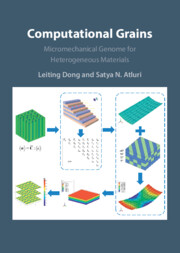Book contents
- Computational Grains
- Computational Grains
- Copyright page
- Contents
- Preface
- 1 Introduction
- 2 Computational Homogenization in the Micromechanics of Heterogeneous Materials
- 3 Direct Numerical Simulation of Materials Using Computational Grains
- 4 Trefftz Trial Functions for Computational Grains for Planar and 3D Problems
- 5 Computational Grains for Particulate Composites and Porous Materials
- 6 Computational Grains for Cylindrical Fiber Composites
- 7 Computational Grains for Nanocomposites
- 8 Computational Grains for Composites with Coated Inclusions
- 9 Computational Grains for Viscoelastic Composites
- 10 Computational Grains for Piezoelectric Composites/Porous Materials
- 11 Computational Grains with Embedded Microcracks in the Matrix and Inclusions
- 12 Multi-Scale Modeling of Composite Structures Using Computational Grains
- Index
- References
10 - Computational Grains for Piezoelectric Composites/Porous Materials
Published online by Cambridge University Press: 05 October 2023
- Computational Grains
- Computational Grains
- Copyright page
- Contents
- Preface
- 1 Introduction
- 2 Computational Homogenization in the Micromechanics of Heterogeneous Materials
- 3 Direct Numerical Simulation of Materials Using Computational Grains
- 4 Trefftz Trial Functions for Computational Grains for Planar and 3D Problems
- 5 Computational Grains for Particulate Composites and Porous Materials
- 6 Computational Grains for Cylindrical Fiber Composites
- 7 Computational Grains for Nanocomposites
- 8 Computational Grains for Composites with Coated Inclusions
- 9 Computational Grains for Viscoelastic Composites
- 10 Computational Grains for Piezoelectric Composites/Porous Materials
- 11 Computational Grains with Embedded Microcracks in the Matrix and Inclusions
- 12 Multi-Scale Modeling of Composite Structures Using Computational Grains
- Index
- References
Summary
In this chapter, a new type of Computational Grains is proposed to study the micro-electro-mechanical behavior of composite piezoelectric materials. This method is based on a new hybrid variational principle, and independently assumed displacements and electric potentials in each CG. Each CG can efficiently model a single physical grain of the composite material, thus saving a significant time of generating complex FEM mesh. Computational Grains can also model porous and composite piezoelectric materials even if the distribution of voids/inclusions is not symmetrical (which is assumption used with all unit cell models). Because the trial solutions are complete but do not satisfy the governing differential equations a priori, the formulation is very simple, and can accurately account for the local field concentrations efficiently and accurately. This is illustrated using different examples where the fields along the void/inclusion periphery are calculated, and the effective material properties of porous and composite materials are predicted, and compared with other analytical and computational models. The proposed CG in this chapter is expected to become a very powerful tool of direct numerical simulations of the micro/meso mechanics of composite piezoelectric materials, and can possibly lead to efficient multi-scale modeling of piezoelectric devices.
Keywords
- Type
- Chapter
- Information
- Computational GrainsMicromechanical Genome for Heterogeneous Materials, pp. 192 - 205Publisher: Cambridge University PressPrint publication year: 2023



